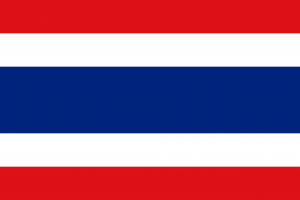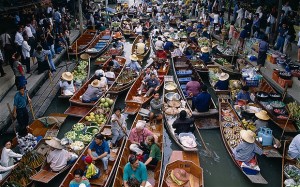 Population of Thailand 2014
Population of Thailand 2014
Based on the total number of births, total number of deaths, net migration rate, and the population of 2013, the current population of the Kingdom of Thailand is estimated to be about 67,149,778, which makes up about 0.93% of the world’s total population. It ranks 20th in the population rankings, behind the Democratic Republic of the Congo, but ahead of France. Thailand is the twelfth-most populous country in Asia. At the end of 2013, Thailand’s population was recorded as 67,010,502. Therefore, since the start of 2014, there has only been a population increase of about 136,276, which indicates a growth rate of 0.2%. Based on the total land area and the total population, the population density of Thailand is estimated to be about 130.87 people per square kilometer or 338.94 people per square mile.
Geography of Thailand 2014
The total land area of Thailand is 513,120 square kilometers or 198,120 square miles, making it the 51st largest country in terms of total area. Relatively speaking, it is larger than Spain, but smaller than Yemen. Northern Thailand is the mountainous region of the country. The highest point in the region is Doi Inthanon in the Thanon Thong Chai Range, reaching 2,565 meters or 8,415 feet. Central Thailand is mainly composed of the Chao Phraya river valley. The river valley helps sustain the agricultural sector of the country. Southern Thailand consists of the Kra Isthmus and the Malay Peninsula. The country is characterized by a tropical climate and frequent monsoons. Lastly, the Gulf of Thailand is a significant source of tourism and industry, especially due to the large number of ports, including the entrance to Bangkok’s Inland Seaport.
Government of Thailand 2014
Thailand is a unitary government operating as a constitutional monarchy under a parliamentary democracy. The monarch of Thailand, King Bhumibol Adulyadej, is the world’s longest reigning monarch. Even though the king, realistically, has very little power, he is a figurehead and a symbol of the Kingdom. He is considered to be the Head of State and the head of the House of Chakri. However, the Head of the Government is the Prime Minister, who is typically the leader of the largest party or the largest coalition party in the lower house of the Parliament. The lower house selects the Prime Minister and then the King appoints him or her. As the leader of the Executive Branch, he or she is the leader of the Cabinet, having the authority to appoint or remove any Minister or Officer as he or she pleases. The current Prime Minister is Yingluck Shinawatra, who is the first female Prime Minister of Thailand. The Parliament is known as the National Assembly of Thailand and is made up of the Senate and the House of Representatives.
Education in Thailand 2014
According to UNICEF, the total adult literacy of Thailand from 2008-2012 is estimated to be about 93.5%. Education is a large part of Thai society. As of 2006, education was 27% of the government’s budget. The education system is broken up into four stages, three of which are compulsory. The first stage consists of the first three years in elementary school for ages 6-8, which is named Prathom 1-3. The second stage consists of the last three years of elementary school for ages 9-11, which is named Prathom 4-6. The third stage consists of the first three years of secondary school for ages 12-14, which is named Matthayom 1-3. The last stage and the last years of secondary school are optional. However, the government does provide free education up through the completion of this last stage. The upper secondary level, named Matthayom 4-6, is for those of ages 15-17. The purpose of this level is to either prepare the students for a career or for the university. Thus, there are academic, vocational, and comprehensive tracks. The academic track is for those that plan to attend a university, while the vocational track is intended for those planning to delve into a career. The comprehensive track is a combination of both programs, intended for students that have not completely decided yet. In order to be admitted to the fourth stage, students must pass through an entrance exam. Then, after each level, he or she must pass the National Education Test to graduate. The government funds the public schools; however, if students may choose, they may pay tuition in order to attend private schools, such as Catholic schools. One fallback of the Thai education system is the usage of rote learning, which utilizes the technique of repetition in order to help the students memorize the information. Some view this technique as unproductive because the students are simply memorizing instead of actually learning. Lastly, the government emphasizes the importance of the English language, thus making the English language a compulsory subject to study and learn in school.
Homeless Population in Thailand
Health Care in Thailand 2014
The Ministry of Public Health oversees the universal health care that has been granted to Thai citizens since 2002. As of 2012, the life expectancy of Thai citizens is 74.2 years, with women generally outliving men. Also, the infant mortality rate is 11 deaths per 1,000 babies; the under-five mortality rate is 13 deaths per 1,000 children. According to the World Health Organization, about 24% of people fie from communicable diseases, 55% of die from non-communicable diseases, and 22% die from injuries. In 2011, about 95.8% of people used improved drinking water sources. Also, about 93.4% of the population used improved sanitation facilities.
The universal health care comprises three programs: a civil service system for civil servants and their families, Social Security system for private employees, and Universal Coverage provided for all others that need the coverage. The World Health Organization reports that 99.5% of the population has health protection. As of 2004, 65% of health expenditures came from the government. Lastly, the Ministry of Public Health operates the public hospitals, but the Medical Registration Division in the Department of Health operates the private hospitals. There are an estimated 316 private hospitals compared to over 1,000 public hospitals.
 Economy of Thailand 2014
Economy of Thailand 2014
Thailand exports about $105 billion worth of goods and services every year. In fact, it is considered to be the largest rice exporter in the world. They export over 6.5 million tons of rice every year. In fact, about 55% of farmable land is used to produce rice. They also export textiles, footwear, rubber, cars, and computers. The Gross Domestic Product in terms of Purchasing Power Parity of Thailand is worth $602 billion, which gives Thailand the second largest economy in Southeast Asia after Indonesia. Currently, about 49% of the labor force is employed in the agricultural industry. According to UNICEF, in 2011, the poorest 40% share about 18% of household income, while the richest 20% share 47% of household income. Lastly, tourism makes up about 6% of the economy.
Other Resources